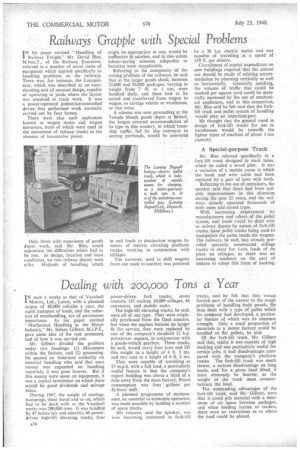Dealing with 203,000 Tons a Year
Page 52

If you've noticed an error in this article please click here to report it so we can fix it.
I N such a works as that of Vauxhall Motors, Ltd., Luton, with' a planned output of 80,000 vehicles a year, the rapid transport of loads, and the reduction of manhandling, are of paramount importance. In his paper entitled " Mechanical Handling in the Motor Industry," Mr. Sidney Gilbert, gave some idea of the task presented, and of how it was carried out.
Mr. Gilbert divided the problem under two headings: (1) Movement within the factory, and (2) processing. He quoted an American authority on material handling Who said that once money was expended on handling materials, it was gone forever. But if this money were spent on equipment, it was a capital investment on which there would be good dividends and salvage value.
During 1947, the weight of castings, stampings, sheet metal and so on, which had to be dealt with at the Vauxhall works was 200,000 tons. It was handled by 47 hoists (air and electric), 40 powerdriven high-lift elevating trucks, four power-driven fork trucks, seven tractors, 135 trailers, 10,089 stillages, 44 conveyors, and mobile racks.
The high-lift elevating trucks, he said, were all of one type. They were originally purchased from the Opel concern, but when the engines became no longer fit for service, they were replaced by one of the company's standard 12 h.p. private-car engines, in conjunction with a goods-vehicle gearbox. These trucks, he said, would carry _four tons and lift this weight to a height of 4 ft. 3 ins. and two tons to a height of 6 ft. 3 ins.
They were capable of travelling at 25 m.p.h. with a full load, a particularly useful feature in that the company's export building was about a 'third of a mile away from the main factory. Petrol consumption was four gallons per 8i-hour shift.
A planned programme of maintenance, an essential to economic operation, was made possible by holding a number of spare trucks.
His concern, said the speaker, was now becoming interested in fork-lift
trucks, and he felt that they woutd furnish part of the answer to the tough problems of handling body panels. He then dealt with a type of pallet which his company had developed, a particular feature of which was its immense strength. Only a small proportion of materials in a motor factory could be handled on flat pallets,, he said.
Of the fork-lift truck, Mr. Gilbert said that, whilst it was capable of high stacking and was particularly useful for certain jobs, it had disadvantages compared with the company's platform trucks. The fork-lift truck was much slower, a seriousdisadvantage on long hauls, and for a given load lifted, it must obviously be heavier, as the weight of the truck must counterbalance the load.
The outstanding advantages of the fork-lift truck, said Mr. Gilbert, were that it could pile material with a minimum of air space between packages, and when loading lorries or trailers, there were no restrictions as to where the load could be placed.




















































































